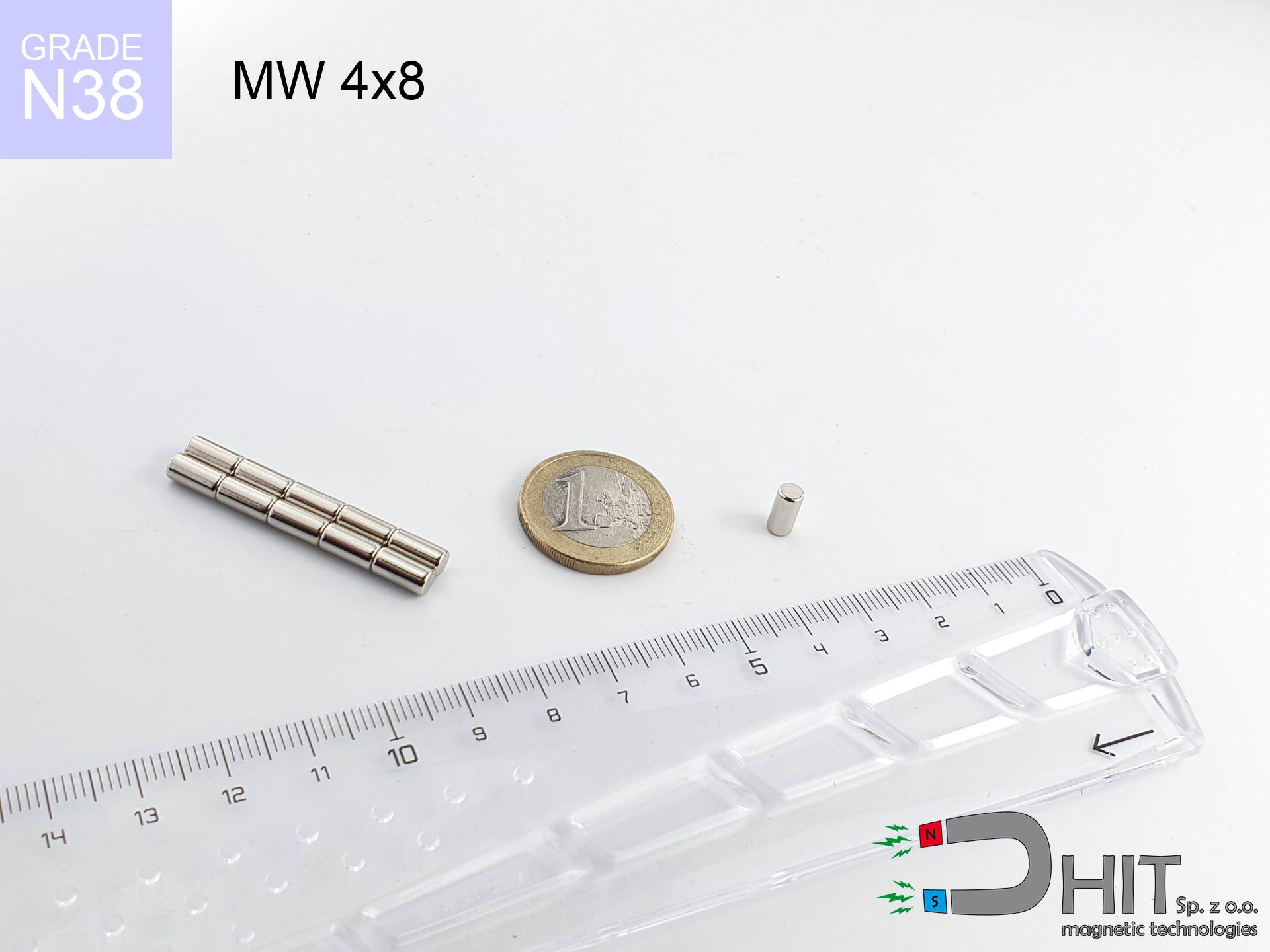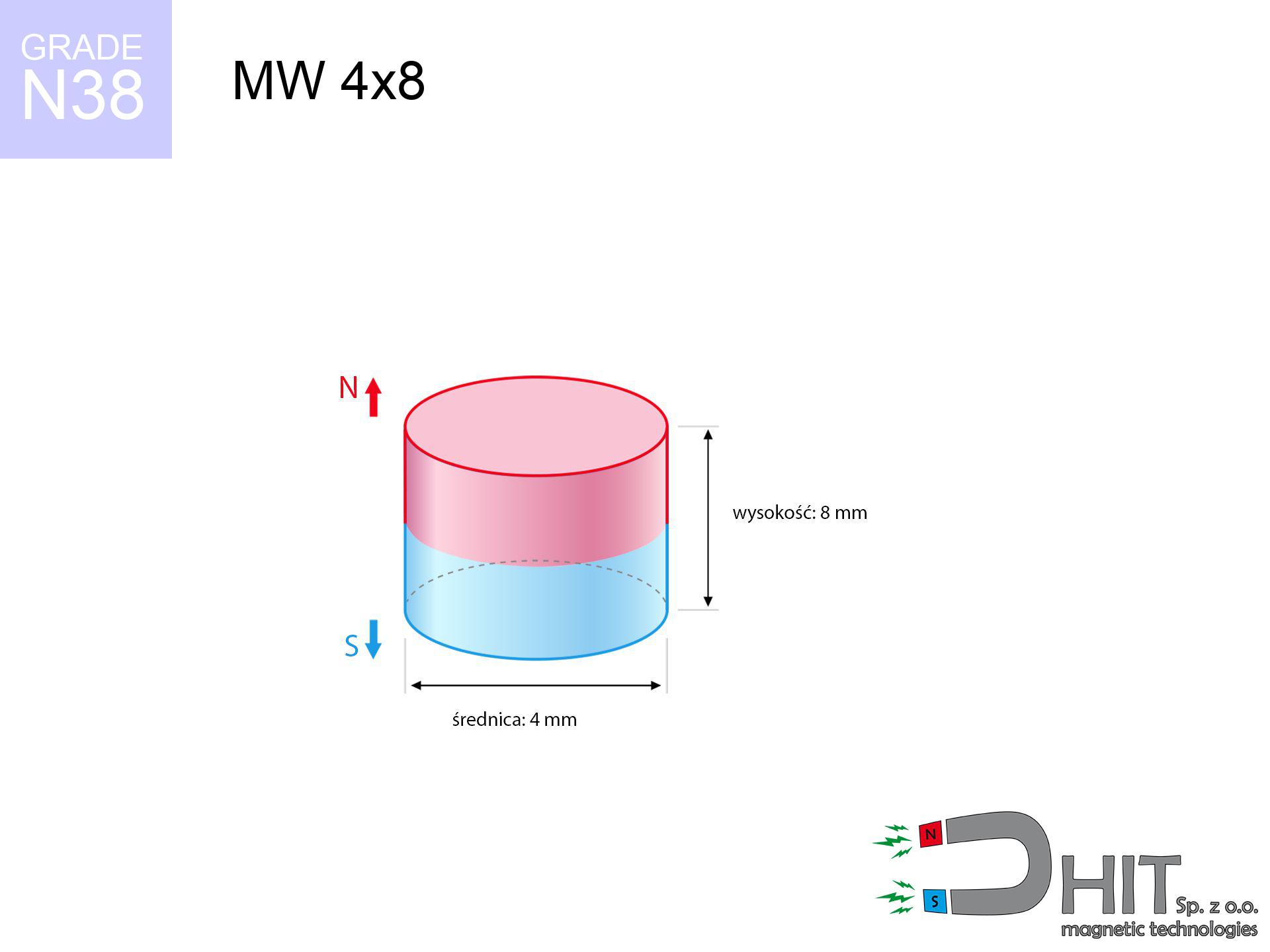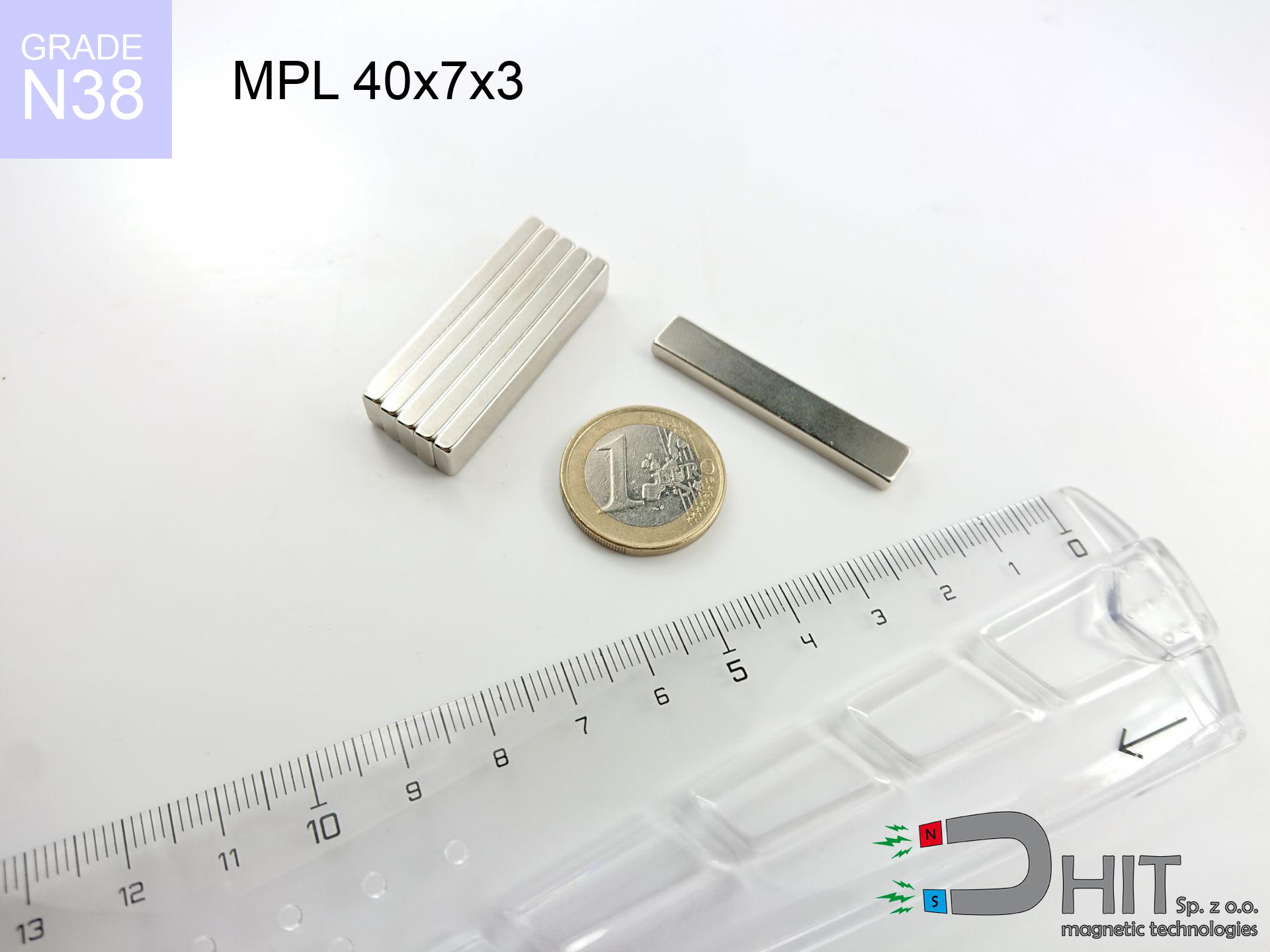MW 4x8 / N38 - cylindrical magnet
cylindrical magnet
Catalog no 010079
GTIN/EAN: 5906301810780
Diameter Ø
4 mm [±0,1 mm]
Height
8 mm [±0,1 mm]
Weight
0.75 g
Magnetization Direction
↑ axial
Load capacity
0.35 kg / 3.48 N
Magnetic Induction
599.59 mT / 5996 Gs
Coating
[NiCuNi] Nickel
0.701 ZŁ with VAT / pcs + price for transport
0.570 ZŁ net + 23% VAT / pcs
bulk discounts:
Need more?
Call us
+48 22 499 98 98
or get in touch via
request form
the contact form page.
Strength as well as form of a magnet can be tested on our
magnetic mass calculator.
Order by 14:00 and we’ll ship today!
Technical data - MW 4x8 / N38 - cylindrical magnet
Specification / characteristics - MW 4x8 / N38 - cylindrical magnet
| properties | values |
|---|---|
| Cat. no. | 010079 |
| GTIN/EAN | 5906301810780 |
| Production/Distribution | Dhit sp. z o.o. |
| Country of origin | Poland / China / Germany |
| Customs code | 85059029 |
| Diameter Ø | 4 mm [±0,1 mm] |
| Height | 8 mm [±0,1 mm] |
| Weight | 0.75 g |
| Magnetization Direction | ↑ axial |
| Load capacity ~ ? | 0.35 kg / 3.48 N |
| Magnetic Induction ~ ? | 599.59 mT / 5996 Gs |
| Coating | [NiCuNi] Nickel |
| Manufacturing Tolerance | ±0.1 mm |
Magnetic properties of material N38
| properties | values | units |
|---|---|---|
| remenance Br [min. - max.] ? | 12.2-12.6 | kGs |
| remenance Br [min. - max.] ? | 1220-1260 | mT |
| coercivity bHc ? | 10.8-11.5 | kOe |
| coercivity bHc ? | 860-915 | kA/m |
| actual internal force iHc | ≥ 12 | kOe |
| actual internal force iHc | ≥ 955 | kA/m |
| energy density [min. - max.] ? | 36-38 | BH max MGOe |
| energy density [min. - max.] ? | 287-303 | BH max KJ/m |
| max. temperature ? | ≤ 80 | °C |
Physical properties of sintered neodymium magnets Nd2Fe14B at 20°C
| properties | values | units |
|---|---|---|
| Vickers hardness | ≥550 | Hv |
| Density | ≥7.4 | g/cm3 |
| Curie Temperature TC | 312 - 380 | °C |
| Curie Temperature TF | 593 - 716 | °F |
| Specific resistance | 150 | μΩ⋅cm |
| Bending strength | 250 | MPa |
| Compressive strength | 1000~1100 | MPa |
| Thermal expansion parallel (∥) to orientation (M) | (3-4) x 10-6 | °C-1 |
| Thermal expansion perpendicular (⊥) to orientation (M) | -(1-3) x 10-6 | °C-1 |
| Young's modulus | 1.7 x 104 | kg/mm² |
Engineering analysis of the magnet - technical parameters
These values are the result of a engineering analysis. Results rely on models for the class Nd2Fe14B. Actual conditions might slightly deviate from the simulation results. Please consider these calculations as a supplementary guide when designing systems.
Table 1: Static pull force (pull vs gap) - interaction chart
MW 4x8 / N38
| Distance (mm) | Induction (Gauss) / mT | Pull Force (kg) | Risk Status |
|---|---|---|---|
| 0 mm |
5984 Gs
598.4 mT
|
0.35 kg / 350.0 g
3.4 N
|
weak grip |
| 1 mm |
3280 Gs
328.0 mT
|
0.11 kg / 105.1 g
1.0 N
|
weak grip |
| 2 mm |
1696 Gs
169.6 mT
|
0.03 kg / 28.1 g
0.3 N
|
weak grip |
| 3 mm |
941 Gs
94.1 mT
|
0.01 kg / 8.7 g
0.1 N
|
weak grip |
| 5 mm |
371 Gs
37.1 mT
|
0.00 kg / 1.3 g
0.0 N
|
weak grip |
| 10 mm |
82 Gs
8.2 mT
|
0.00 kg / 0.1 g
0.0 N
|
weak grip |
| 15 mm |
31 Gs
3.1 mT
|
0.00 kg / 0.0 g
0.0 N
|
weak grip |
| 20 mm |
15 Gs
1.5 mT
|
0.00 kg / 0.0 g
0.0 N
|
weak grip |
| 30 mm |
5 Gs
0.5 mT
|
0.00 kg / 0.0 g
0.0 N
|
weak grip |
| 50 mm |
1 Gs
0.1 mT
|
0.00 kg / 0.0 g
0.0 N
|
weak grip |
Table 2: Slippage load (vertical surface)
MW 4x8 / N38
| Distance (mm) | Friction coefficient | Pull Force (kg) |
|---|---|---|
| 0 mm | Stal (~0.2) |
0.07 kg / 70.0 g
0.7 N
|
| 1 mm | Stal (~0.2) |
0.02 kg / 22.0 g
0.2 N
|
| 2 mm | Stal (~0.2) |
0.01 kg / 6.0 g
0.1 N
|
| 3 mm | Stal (~0.2) |
0.00 kg / 2.0 g
0.0 N
|
| 5 mm | Stal (~0.2) |
0.00 kg / 0.0 g
0.0 N
|
| 10 mm | Stal (~0.2) |
0.00 kg / 0.0 g
0.0 N
|
| 15 mm | Stal (~0.2) |
0.00 kg / 0.0 g
0.0 N
|
| 20 mm | Stal (~0.2) |
0.00 kg / 0.0 g
0.0 N
|
| 30 mm | Stal (~0.2) |
0.00 kg / 0.0 g
0.0 N
|
| 50 mm | Stal (~0.2) |
0.00 kg / 0.0 g
0.0 N
|
Table 3: Vertical assembly (sliding) - behavior on slippery surfaces
MW 4x8 / N38
| Surface type | Friction coefficient / % Mocy | Max load (kg) |
|---|---|---|
| Raw steel |
µ = 0.3
30% Nominalnej Siły
|
0.11 kg / 105.0 g
1.0 N
|
| Painted steel (standard) |
µ = 0.2
20% Nominalnej Siły
|
0.07 kg / 70.0 g
0.7 N
|
| Oily/slippery steel |
µ = 0.1
10% Nominalnej Siły
|
0.03 kg / 35.0 g
0.3 N
|
| Magnet with anti-slip rubber |
µ = 0.5
50% Nominalnej Siły
|
0.18 kg / 175.0 g
1.7 N
|
Table 4: Steel thickness (saturation) - power losses
MW 4x8 / N38
| Steel thickness (mm) | % power | Real pull force (kg) |
|---|---|---|
| 0.5 mm |
|
0.03 kg / 35.0 g
0.3 N
|
| 1 mm |
|
0.09 kg / 87.5 g
0.9 N
|
| 2 mm |
|
0.18 kg / 175.0 g
1.7 N
|
| 5 mm |
|
0.35 kg / 350.0 g
3.4 N
|
| 10 mm |
|
0.35 kg / 350.0 g
3.4 N
|
Table 5: Thermal resistance (material behavior) - thermal limit
MW 4x8 / N38
| Ambient temp. (°C) | Power loss | Remaining pull | Status |
|---|---|---|---|
| 20 °C | 0.0% |
0.35 kg / 350.0 g
3.4 N
|
OK |
| 40 °C | -2.2% |
0.34 kg / 342.3 g
3.4 N
|
OK |
| 60 °C | -4.4% |
0.33 kg / 334.6 g
3.3 N
|
OK |
| 80 °C | -6.6% |
0.33 kg / 326.9 g
3.2 N
|
|
| 100 °C | -28.8% |
0.25 kg / 249.2 g
2.4 N
|
Table 6: Two magnets (attraction) - field range
MW 4x8 / N38
| Gap (mm) | Attraction (kg) (N-S) | Repulsion (kg) (N-N) |
|---|---|---|
| 0 mm |
2.77 kg / 2774 g
27.2 N
6 121 Gs
|
N/A |
| 1 mm |
1.59 kg / 1591 g
15.6 N
9 063 Gs
|
1.43 kg / 1432 g
14.0 N
~0 Gs
|
| 2 mm |
0.83 kg / 833 g
8.2 N
6 559 Gs
|
0.75 kg / 750 g
7.4 N
~0 Gs
|
| 3 mm |
0.43 kg / 427 g
4.2 N
4 694 Gs
|
0.38 kg / 384 g
3.8 N
~0 Gs
|
| 5 mm |
0.12 kg / 121 g
1.2 N
2 498 Gs
|
0.11 kg / 109 g
1.1 N
~0 Gs
|
| 10 mm |
0.01 kg / 11 g
0.1 N
743 Gs
|
0.01 kg / 10 g
0.1 N
~0 Gs
|
| 20 mm |
0.00 kg / 1 g
0.0 N
165 Gs
|
0.00 kg / 0 g
0.0 N
~0 Gs
|
| 50 mm |
0.00 kg / 0 g
0.0 N
17 Gs
|
0.00 kg / 0 g
0.0 N
~0 Gs
|
Table 7: Protective zones (electronics) - warnings
MW 4x8 / N38
| Object / Device | Limit (Gauss) / mT | Safe distance |
|---|---|---|
| Pacemaker | 5 Gs (0.5 mT) | 3.5 cm |
| Hearing aid | 10 Gs (1.0 mT) | 2.5 cm |
| Mechanical watch | 20 Gs (2.0 mT) | 2.0 cm |
| Mobile device | 40 Gs (4.0 mT) | 1.5 cm |
| Remote | 50 Gs (5.0 mT) | 1.5 cm |
| Payment card | 400 Gs (40.0 mT) | 0.5 cm |
| HDD hard drive | 600 Gs (60.0 mT) | 0.5 cm |
Table 8: Collisions (kinetic energy) - warning
MW 4x8 / N38
| Start from (mm) | Speed (km/h) | Energy (J) | Predicted outcome |
|---|---|---|---|
| 10 mm |
21.79 km/h
(6.05 m/s)
|
0.01 J | |
| 30 mm |
37.74 km/h
(10.48 m/s)
|
0.04 J | |
| 50 mm |
48.72 km/h
(13.53 m/s)
|
0.07 J | |
| 100 mm |
68.89 km/h
(19.14 m/s)
|
0.14 J |
Table 9: Surface protection spec
MW 4x8 / N38
| Technical parameter | Value / Description |
|---|---|
| Coating type | [NiCuNi] Nickel |
| Layer structure | Nickel - Copper - Nickel |
| Layer thickness | 10-20 µm |
| Salt spray test (SST) ? | 24 h |
| Recommended environment | Indoors only (dry) |
Table 10: Construction data (Flux)
MW 4x8 / N38
| Parameter | Value | SI Unit / Description |
|---|---|---|
| Magnetic Flux | 836 Mx | 8.4 µWb |
| Pc Coefficient | 1.21 | High (Stable) |
Table 11: Underwater work (magnet fishing)
MW 4x8 / N38
| Environment | Effective steel pull | Effect |
|---|---|---|
| Air (land) | 0.35 kg | Standard |
| Water (riverbed) |
0.40 kg
(+0.05 kg Buoyancy gain)
|
+14.5% |
1. Shear force
*Note: On a vertical wall, the magnet holds only approx. 20-30% of its perpendicular strength.
2. Steel saturation
*Thin steel (e.g. computer case) drastically limits the holding force.
3. Temperature resistance
*For N38 material, the max working temp is 80°C.
4. Demagnetization curve and operating point (B-H)
chart generated for the permeance coefficient Pc (Permeance Coefficient) = 1.21
The chart above illustrates the magnetic characteristics of the material within the second quadrant of the hysteresis loop. The solid red line represents the demagnetization curve (material potential), while the dashed blue line is the load line based on the magnet's geometry. The Pc (Permeance Coefficient), also known as the load line slope, is a dimensionless value that describes the relationship between the magnet's shape and its magnetic stability. The intersection of these two lines (the black dot) is the operating point — it determines the actual magnetic flux density generated by the magnet in this specific configuration. A higher Pc value means the magnet is more 'slender' (tall relative to its area), resulting in a higher operating point and better resistance to irreversible demagnetization caused by external fields or temperature. A value of 0.42 is relatively low (typical for flat magnets), meaning the operating point is closer to the 'knee' of the curve — caution is advised when operating at temperatures near the maximum limit to avoid strength loss.
Material specification
| iron (Fe) | 64% – 68% |
| neodymium (Nd) | 29% – 32% |
| boron (B) | 1.1% – 1.2% |
| dysprosium (Dy) | 0.5% – 2.0% |
| coating (Ni-Cu-Ni) | < 0.05% |
Environmental data
| recyclability (EoL) | 100% |
| recycled raw materials | ~10% (pre-cons) |
| carbon footprint | low / zredukowany |
| waste code (EWC) | 16 02 16 |
See also deals
Advantages as well as disadvantages of Nd2Fe14B magnets.
Strengths
- They do not lose strength, even after nearly ten years – the reduction in power is only ~1% (theoretically),
- Neodymium magnets are exceptionally resistant to magnetic field loss caused by external magnetic fields,
- The use of an metallic coating of noble metals (nickel, gold, silver) causes the element to have aesthetics,
- Magnets are distinguished by impressive magnetic induction on the working surface,
- Neodymium magnets are characterized by extremely high magnetic induction on the magnet surface and are able to act (depending on the form) even at a temperature of 230°C or more...
- Thanks to the option of precise shaping and adaptation to unique projects, NdFeB magnets can be modeled in a variety of forms and dimensions, which expands the range of possible applications,
- Versatile presence in electronics industry – they are used in HDD drives, drive modules, advanced medical instruments, also multitasking production systems.
- Thanks to concentrated force, small magnets offer high operating force, occupying minimum space,
Disadvantages
- Brittleness is one of their disadvantages. Upon strong impact they can fracture. We advise keeping them in a special holder, which not only protects them against impacts but also increases their durability
- We warn that neodymium magnets can reduce their strength at high temperatures. To prevent this, we recommend our specialized [AH] magnets, which work effectively even at 230°C.
- When exposed to humidity, magnets start to rust. For applications outside, it is recommended to use protective magnets, such as magnets in rubber or plastics, which secure oxidation and corrosion.
- Limited ability of making nuts in the magnet and complex forms - preferred is casing - magnet mounting.
- Possible danger resulting from small fragments of magnets can be dangerous, if swallowed, which gains importance in the aspect of protecting the youngest. Additionally, tiny parts of these products can complicate diagnosis medical when they are in the body.
- Due to neodymium price, their price is relatively high,
Lifting parameters
Breakaway strength of the magnet in ideal conditions – what affects it?
- with the application of a sheet made of low-carbon steel, guaranteeing maximum field concentration
- whose thickness equals approx. 10 mm
- characterized by smoothness
- with total lack of distance (no coatings)
- for force applied at a right angle (in the magnet axis)
- in stable room temperature
What influences lifting capacity in practice
- Space between surfaces – even a fraction of a millimeter of distance (caused e.g. by veneer or unevenness) drastically reduces the magnet efficiency, often by half at just 0.5 mm.
- Direction of force – maximum parameter is available only during pulling at a 90° angle. The resistance to sliding of the magnet along the surface is usually many times lower (approx. 1/5 of the lifting capacity).
- Base massiveness – too thin steel does not close the flux, causing part of the flux to be lost to the other side.
- Material type – the best choice is high-permeability steel. Hardened steels may attract less.
- Surface structure – the smoother and more polished the plate, the better the adhesion and higher the lifting capacity. Unevenness acts like micro-gaps.
- Thermal factor – hot environment reduces magnetic field. Exceeding the limit temperature can permanently damage the magnet.
Lifting capacity testing was carried out on a smooth plate of suitable thickness, under perpendicular forces, in contrast under parallel forces the load capacity is reduced by as much as 5 times. Additionally, even a minimal clearance between the magnet and the plate lowers the holding force.
H&S for magnets
Dust explosion hazard
Fire hazard: Neodymium dust is highly flammable. Do not process magnets without safety gear as this risks ignition.
Thermal limits
Regular neodymium magnets (grade N) undergo demagnetization when the temperature exceeds 80°C. The loss of strength is permanent.
Pacemakers
Health Alert: Strong magnets can turn off heart devices and defibrillators. Stay away if you have medical devices.
No play value
These products are not intended for children. Eating several magnets may result in them attracting across intestines, which constitutes a critical condition and requires immediate surgery.
Cards and drives
Device Safety: Neodymium magnets can damage data carriers and sensitive devices (pacemakers, hearing aids, mechanical watches).
Finger safety
Pinching hazard: The pulling power is so immense that it can result in blood blisters, pinching, and broken bones. Use thick gloves.
Conscious usage
Be careful. Neodymium magnets act from a distance and connect with huge force, often quicker than you can react.
Fragile material
Despite the nickel coating, the material is delicate and cannot withstand shocks. Avoid impacts, as the magnet may shatter into sharp, dangerous pieces.
Metal Allergy
Allergy Notice: The Ni-Cu-Ni coating consists of nickel. If redness happens, cease handling magnets and wear gloves.
Magnetic interference
Remember: rare earth magnets produce a field that interferes with sensitive sensors. Maintain a safe distance from your mobile, tablet, and GPS.









